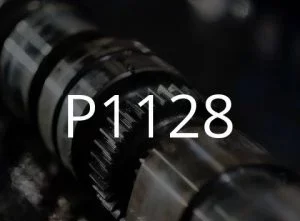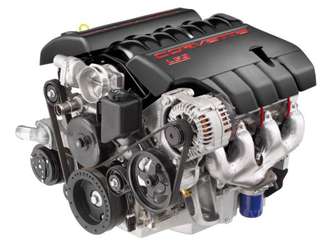
P1128 (Volkswagen, Audi, Skoda, Seat) Long-term engine fuel control system (under load), bank 1 – mixture too lean
Content
P1128 – OBD-II Trouble Code Technical Description
Trouble code P1128 indicates that the air-fuel mixture is too lean (under load) in engine block 1 in Volkswagen, Audi, Skoda, Seat vehicles.
What does the fault code mean P1128?
Trouble code P1128 indicates that the engine (bank 1) fuel/air mixture is too lean, especially when running under load. This means that there is too little fuel in the mixture compared to the amount of air needed for proper combustion. This phenomenon can be caused by a variety of factors, including problems with the fuel system (for example, faulty injectors or fuel pressure), insufficient air supply (for example, due to a clogged air filter or a defective intake system), and malfunctions in the engine management system, such as like sensors or electronic devices.

Possible reasons
Several possible causes for the P1128 trouble code:
- Faulty injectors: If the injectors are not working properly for some reason, they may not be delivering enough fuel to the cylinders, resulting in a lean air-fuel mixture.
- Low fuel pressure: Low fuel system pressure may result in insufficient fuel reaching the cylinders.
- Clogged air filter: A clogged air filter can restrict air flow to the engine, resulting in a lean mixture.
- Sensor Issues: Faulty mass air flow (MAF), air temperature, or intake pressure sensors can cause an incorrect fuel-to-air ratio.
- Problems with the fuel injection system: Improper operation of the fuel injection system, such as faulty valves or regulators, can result in insufficient fuel being delivered to the cylinders.
- Oxygen sensor problems: A defective oxygen sensor may provide incorrect feedback to the engine management system, which may result in incorrect mixture adjustment.
What are the symptoms of a fault code? P1128?
Symptoms for DTC P1128 may include the following:
- Increased fuel consumption: A lean air/fuel mixture can result in increased fuel consumption because the engine may need more fuel to maintain normal operation.
- Loss of power: A lean mixture can cause the engine to lose power because there is not enough fuel to keep the cylinders fully firing.
- Uneven engine operation: The engine may run rough or jerk due to improper fuel to air ratio.
- Braking when accelerating: When accelerating, the vehicle may slow down due to insufficient fuel to provide normal response to the gas pedal.
- Unstable idle: Rough idle may occur due to insufficient fuel being supplied to the cylinders at low speeds.
- The appearance of smoke from the exhaust pipe: White or blue smoke may appear from the exhaust pipe due to a lean mixture that may not be completely burned.
How to diagnose a fault code P1128?
To diagnose DTC P1128, you can follow these steps:
- Checking the fuel system: Check the fuel system for leaks or fuel delivery problems. Check the condition of the fuel pump, fuel filter and injectors.
- Checking sensors: Check the operation of the oxygen (O2) and mass air flow (MAF) sensors. The sensors may be dirty or faulty, which can cause the fuel to air ratio to be incorrect.
- Checking the air flow: Check the air flow through the air filter and the mass air flow (MAF). Improper airflow can result in an incorrect fuel/air mixture.
- Checking the ignition system: Check the condition of the spark plugs, ignition coils and wires. Improper operation of the ignition system can lead to improper combustion of the fuel and air mixture.
- Checking the exhaust system: Check the exhaust system for leaks or obstructions. Improper operation of the exhaust system can result in insufficient combustion efficiency.
- Fuel pressure check: Check the fuel pressure in the fuel system. Insufficient fuel pressure can result in a lean mixture.
- Checking the car computer: Check your vehicle's computer for error codes and sensor data to determine possible problems with the engine management system.
After carrying out the above checks, it will be possible to identify the possible causes and eliminate the malfunctions that cause the P1128 code.
Diagnostic errors
When diagnosing DTC P1128, the following errors may occur:
- Incomplete diagnosis: Some mechanics may focus on only one aspect, such as the oxygen sensors or fuel injection system, and not check other possible causes.
- Misinterpretation of data: The interpretation of the code reader data may be incorrect, causing the problem to be incorrectly identified.
- Wrong solution to the problem: Some mechanics may suggest replacing components without performing a full diagnosis, which may result in unnecessary expense or failure to resolve the problem.
- Neglect of the state of other systems: Some problems may be related to other vehicle systems, such as the ignition system or intake system, and their condition may be neglected during diagnosis.
- Incorrect component configuration: When replacing components such as oxygen sensors or mass air flow sensors, adjustment or calibration may be required and may be skipped.
It is important to fully investigate all possible causes of the P1128 code and ensure the correct solution to the problem to avoid diagnostic and repair errors.
How serious is the fault code? P1128?
Trouble code P1128 is serious because it indicates a problem with the engine's fuel system, which can result in inefficient combustion of the air-fuel mixture. Insufficient or excess fuel in the mixture can lead to various problems such as loss of engine power, improper functioning of the emission system, increased emissions of harmful substances, and increased fuel consumption. Therefore, it is important to take measures to correct this problem as soon as possible to prevent possible engine damage and minimize the negative impact on the environment.
What repair will help eliminate the code? P1128?
To resolve the P1128 code, follow these steps:
- Check the fuel system: Make sure the fuel pump is functioning correctly and is providing sufficient fuel pressure to the system. Check the fuel filter for blockages.
- Check the oxygen sensor: Check the operation of the oxygen sensor (HO2S) in bank 1 to ensure that it is sending the correct signals to the ECU.
- Check the Mass Air Flow (MAF) Sensor: The MAF sensor can also cause the fuel mixture to become lean or rich. Make sure it is clean and working correctly.
- Check for Vacuum Leaks: Leaks in the vacuum system can cause erroneous signals in the fuel management system, which in turn can cause problems with the fuel mixture.
- Check the throttle: The throttle can cause an incorrect fuel to air ratio, resulting in a lean or rich mixture.
- Check the exhaust system: Obstructions or damage in the exhaust system can lead to improper removal of exhaust gases and, consequently, to changes in the fuel mixture.
After identifying and eliminating the possible cause of the malfunction, it is necessary to erase the fault code from the computer memory using a diagnostic scanner.

